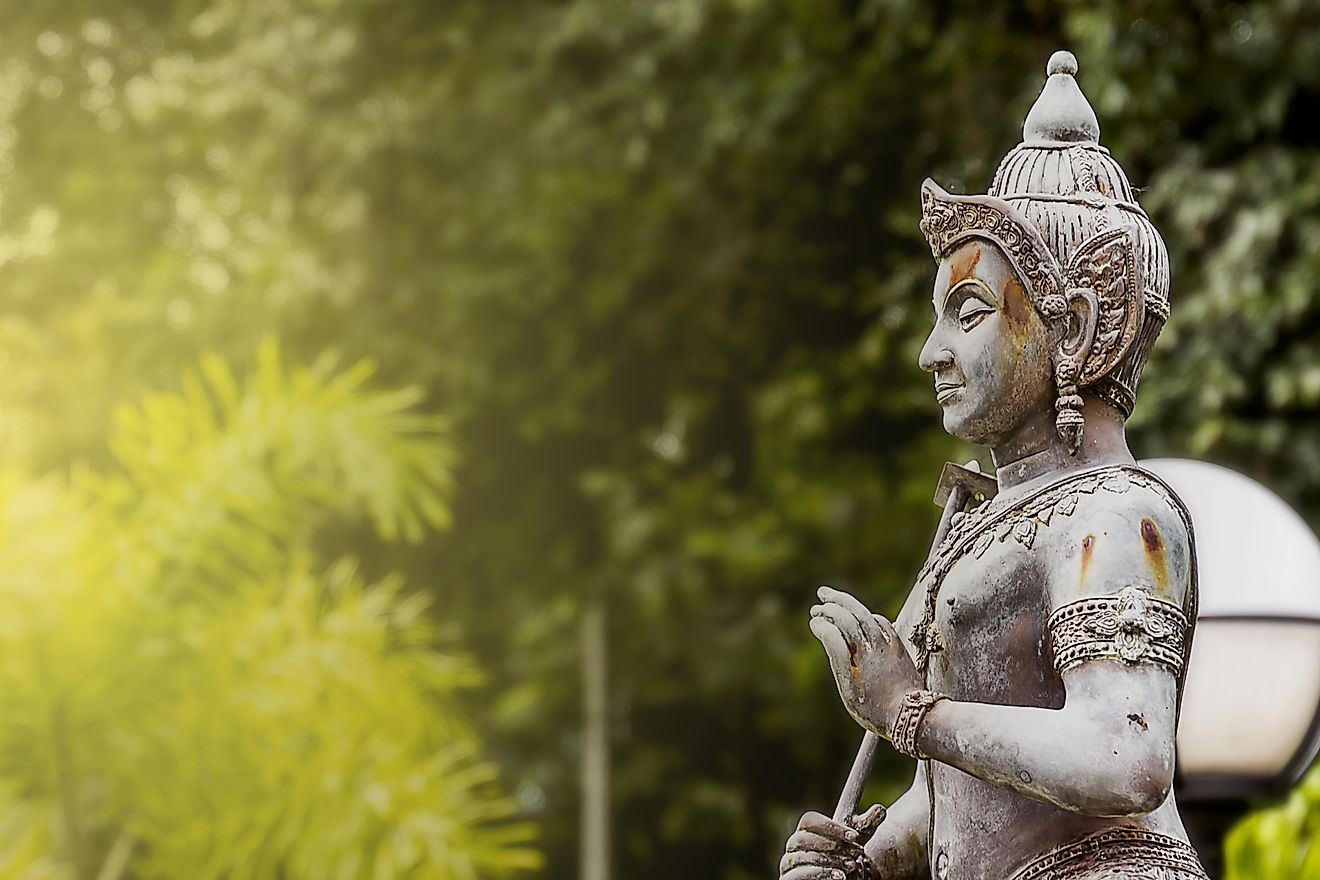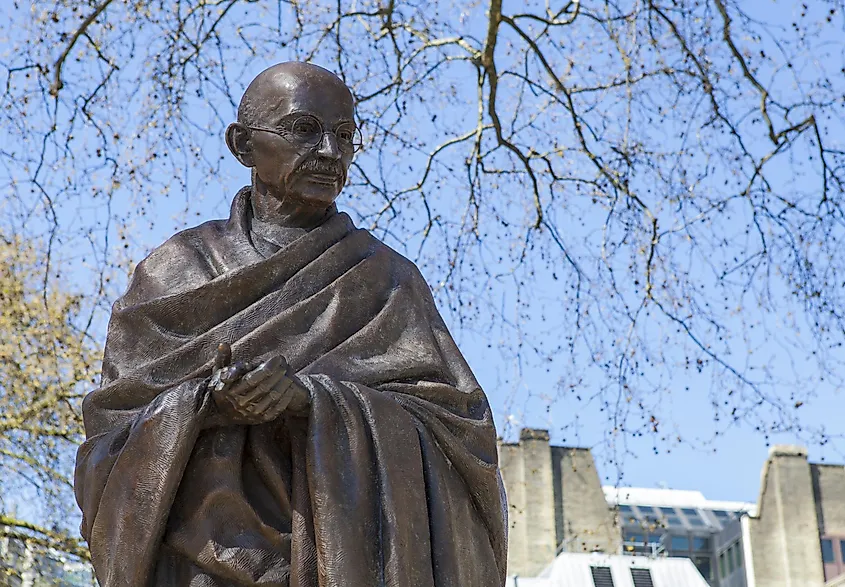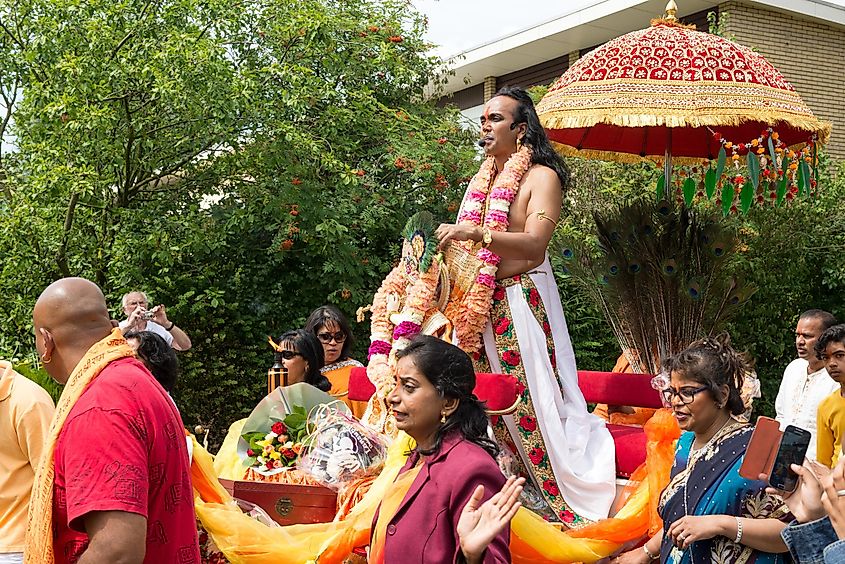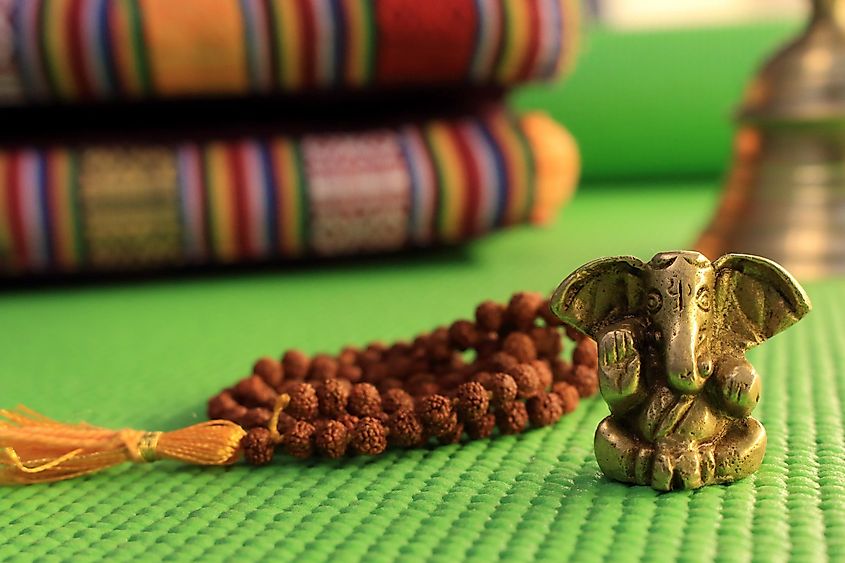European Countries With The Highest Number Of Hindus: 2010 To 2050

- Europe is now home to about 1.3 million followers of Hinduism.
- Places like Gibraltar, the UK, and the Netherlands have some of the largest Hindu populations in Europe.
- Countries like Denmark are expected to see the Hindu population almost double by 2050, largely due to migration.
The Hindu religion is an ancient faith that can trace its roots all the way back to between 2300 and 1500 BCE in the Indus Valley, close to what is now Pakistan.
Many other religions began with one founding person, such as Christianity with the teachings of Jesus, and Islam, with those of Muhammad. Hinduism is unique, however, as it began with the fusion of many pre-existing beliefs.
Today, Hinduism is the third-largest organized religion in the world, following closely behind Christianity and Islam. Over a billion people presently follow the Hindu religion, with the majority living in South Asia. Many Hindus also inhabit other parts of the world however, and this includes Europe, which is home to about 1.3 million followers of the faith. There are now said to be between two to five generations of Hindu descendants living in Europe, making Hinduism one of the largest religious minorities on the continent.
How did people of Hindu faith end up congregating in Europe? Immigration occurred in waves, beginning all the way back in the 19th century. Hindu scholars and gurus moved to Europe to get an education during these times. This included the infamous Gandhi, who studied to be a barrister in London, England.

Following the nationalization of the former British colonies in the 1960s and 1970s, many more Hindus migrated to Europe from India and East Africa, often with British passports allowing them to pursue a future in Britain. Many more Hindus came in another wave of migration starting in the early 1980s spurred by the conflict in Sri Lanka that targeted Tamils.
Hindus in Europe originate from different countries and practice their faith in different ways, depending on the group of Hinduism they belong to. It is important to know that many distinguish themselves from other groups depending on their ethnicity and cultural heritage.
Why Hindus Migrate
People migrate away from their country of birth for many reasons. Sometimes war makes people leave, or reduced economic and educational opportunities can make migrants move in search of a more prosperous future. Where have Hindus migrated to? From 1955 to 1975, the highest number of people migrated from India to England. While not all were Hindus, a majority were. These people were largely from the Punjab and Gujarat regions of India, and they migrated for economic reasons. There was more money to be made at that time for migrants to the UK than there was in India for many people.
The Netherlands has also been a top destination for migrating Hindus, worldwide. Many Hindus who originally arrived in the country did not come directly from places like India, however. Hindus began arriving in the Netherlands in larger numbers beginning in the 1970s. This group came from Suriname, which was a Dutch colony up until 1975.
The original Suriname Indians were bonded laborers who had left the areas of India that are now the states of Bihar and Uttar Pradesh back in the late 1800s. They had done so in order to work on sugar plantations, in response to chaotic government and famine in their homeland. When this migration was stopped, some Indians returned to India, and others continued living in Suriname and the other Caribbean countries to which they had migrated.
The Netherlands granted Suriname its independence in 1975. When this happened many Suriname Indians considered migrating again, as the economic and political future of the country now seemed uncertain, and they chose to move with their colonizer onto the Netherlands.
Today, the Netherlands is home to between 150,000 and 200,000 Hindus.

Future Trends
It is predicted that by the year 2050, the UK, Gibraltar, Denmark, Norway, and the Netherlands will be the countries with the highest number of Hindus in Europe. According to Pew Research Center, the percentage of Hindus is expected to almost double in Denmark, and to rise in the UK by 2050.
These rises in percentage will likely be attributed to migration. There are people of European background who do consider themselves to be “converted Hindus” in Europe, but this is due to self-labeling. This represents a very small portion of Hindus on the continent. Traditionally speaking, a person cannot convert to Hinduism, and the only way to be a Hindu is to be born into a Hindu family. This is because the religion has no process or ritual for conversion to the faith. Hinduism promotes the idea of following your own religion, whatever that may be, in order to feel spiritually fulfilled.

As such, a change in the overall percentage of Hindus in any given population is not likely due to conversions to the faith. Some of the cultural markers of Hinduism such as practicing yoga, following the teachings of a guru, believing in reincarnation, and celebrating festivals like Diwali are becoming more integrated into European culture. Newly becoming an actual Hindu is rare, however.
What about Hindu families having more children? It is also true that while the Hindu Total Fertility Rate worldwide is above the replacement level of 2.1 children per woman, it is lower than average in Europe, however. There, it sits at 1.5 children per woman. Because of this, it is clear that the Hindus now present in Europe are not having large families to such a degree that it would increase their presence in the overall population. Any rise in the percentage of Hindus in populations in Europe will be due to increases in migration. People will continue to migrate to Europe for educational opportunities, as well as economic advancement, in order to better their own future and that of their families.
European Countries With The Highest Number Of Hindus: 2010 To 2050
| Rank | Country | Hindus in 2010 | Country | Hindus Projected in 2050 |
|---|---|---|---|---|
| 1 | Gibraltar | 1.8% | United Kingdom | 2.0% |
| 2 | United Kingdom | 1.4% | Gibraltar | 1.8% |
| 3 | Andorra | 0.5% | Denmark | 0.9% |
| 4 | Netherlands | 0.5% | Norway | 0.9% |
| 5 | Norway | 0.5% | Netherlands | 0.7% |
| 6 | Switzerland | 0.5% | Ireland | 0.6% |
| 7 | Denmark | 0.4% | Switzerland | 0.6% |
| 8 | Iceland | 0.3% | Andorra | 0.5% |
| 9 | Europe (All) | 0.2% | Italy | 0.5% |
| 10 | Ireland | 0.2% | Sweden | 0.5% |
| 11 | Isle of Man | 0.2% | Europe (All) | 0.4% |
| 12 | Malta | 0.2% | Iceland | 0.4% |
| 13 | Sweden | 0.2% | Belgium | 0.3% |
| 14 | Greece | 0.1% | Greece | 0.3% |
| 15 | Italy | 0.1% | Austria | 0.2% |
| 16 | Albania | < 0.1% | Finland | 0.2% |
| 17 | Austria | < 0.1% | Isle of Man | 0.2% |
| 18 | Belarus | < 0.1% | Malta | 0.2% |
| 19 | Belgium | < 0.1% | Spain | 0.2% |
| 20 | Bosnia-Herzegovina | < 0.1% | Ukraine | 0.2% |
| 21 | Bulgaria | < 0.1% | France | 0.1% |
| 22 | Channel Islands | < 0.1% | Germany | 0.1% |
| 23 | Croatia | < 0.1% | Portugal | 0.1% |
| 24 | Czech Republic | < 0.1% | Russia | 0.1% |
| 25 | Estonia | < 0.1% | Albania | < 0.1% |
| 26 | Faeroe Islands | < 0.1% | Belarus | < 0.1% |
| 27 | Finland | < 0.1% | Bosnia-Herzegovina | < 0.1% |
| 28 | France | < 0.1% | Bulgaria | < 0.1% |
| 29 | Georgia | < 0.1% | Channel Islands | < 0.1% |
| 30 | Germany | < 0.1% | Croatia | < 0.1% |
| 31 | Hungary | < 0.1% | Czech Republic | < 0.1% |
| 32 | Kosovo | < 0.1% | Estonia | < 0.1% |
| 33 | Latvia | < 0.1% | Faeroe Islands | < 0.1% |
| 34 | Liechtenstein | < 0.1% | Georgia | < 0.1% |
| 35 | Lithuania | < 0.1% | Hungary | < 0.1% |
| 36 | Luxembourg | < 0.1% | Kosovo | < 0.1% |
| 37 | Moldova | < 0.1% | Latvia | < 0.1% |
| 38 | Monaco | < 0.1% | Liechtenstein | < 0.1% |
| 39 | Montenegro | < 0.1% | Lithuania | < 0.1% |
| 40 | Poland | < 0.1% | Luxembourg | < 0.1% |
| 41 | Portugal | < 0.1% | Moldova | < 0.1% |
| 42 | Republic of Macedonia | < 0.1% | Monaco | < 0.1% |
| 43 | Romania | < 0.1% | Montenegro | < 0.1% |
| 44 | Russia | < 0.1% | Poland | < 0.1% |
| 45 | San Marino | < 0.1% | Republic of Macedonia | < 0.1% |
| 46 | Serbia | < 0.1% | Romania | < 0.1% |
| 47 | Slovakia | < 0.1% | San Marino | < 0.1% |
| 48 | Slovenia | < 0.1% | Serbia | < 0.1% |
| 49 | Spain | < 0.1% | Slovakia | < 0.1% |
| 50 | Ukraine | < 0.1% | Slovenia | < 0.1% |
| 51 | Vatican City | < 0.1% | Vatican City | < 0.1% |











